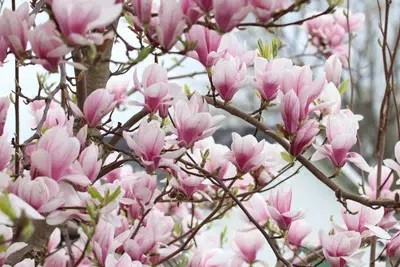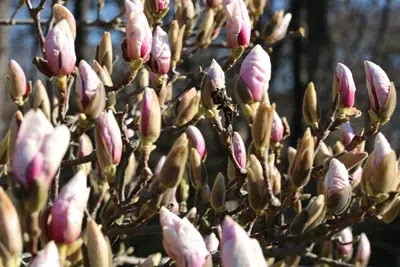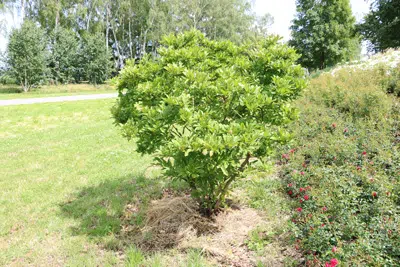The flowers of numerous varieties of magnolia herald the arrival of spring and show immensely decorative with their lush blooms. As one of the first plant species, they bring color into the usually still gray days. Others emphasize the summer ambience with their blossoms. Annoying, if the bloom of the magnolia is waiting. This can have different causes, which are described in detail below along with solutions.
Contents
Variety and age decisive
Full of anticipation, most amateur gardeners plant a magnolia in their garden. If optimal conditions for the location as well as the soil have been met, always diligently watered and well cared for, magnolias grow relatively quickly. But if in the following year and the following year still no flowers appear, this is most likely due to the variety or age.
Two to ten years waiting period
In principle, flowering is not to be expected in the first two years of standing. Mostly it is due to the variety as well as the layout of the tree. Every Magnolia needs at least this period of time to settle. Nutrients in the soil are first consumed for growth. As a rule, the need for nutrients for growth does not subside until a magnolia reaches a certain height of growth. Subsequently, the nutrient uptake is distributed more evenly and then also favors flower formation. Under certain circumstances and depending on the variety, this can take up to ten years.
Flowering time
If a magnolia in your neighbor’s garden is already in full bloom in March, but your own does not produce any flowers until the end of May, this may be due to different varieties. These are divided into early and late varieties. For early varieties, a late frost can delay flower formation and/or promptly destroy an existing bloom. In return, chances are good that an early variety will bloom a second time during the gardening season. A late variety is not affected by late frost, but for this it does not bloom twice.
The following list shows some examples:
Early varieties
- Star magnolia (Magnolia stellata) – flowering in March
- Kobushi magnolia (Magnolia kobus) – flowering time March to April
- Tulip magnolia (Magnolia soulangiana) – flowering in April
- Umbrella magnolia (Magnolia tripetala) – flowering April to May
Late varieties
- Purple magnolia (Magnolia liliiflora) – flowering in May
- Cucumber magnolia (Magnolia acuminata) – flowering from May to June
- Large-leaved magnolia (Magnolia macrophylla) – flowering from May to June
- Evergreen magnolia (Magnolia grandiflora) – flowering from May to August
- Summer magnolia (Magnolia sieboldii) – flowering from June to July
Frozen buds
Magnolia already sets its buds between late summer and early fall. The flowers then form from these in the spring or early summer. This assumes that the buds are not damaged during the winter. This can happen if icy cold weather freezes them. This destroys them and they do not develop further into flowers.

Check sensitivity to frost
It should be taken into account that magnolias are frost-resistant, but often not winter-hardy. That is, if frost-resistant, it can easily tolerate temperatures just below zero degrees Celsius, while hardy magnolia trees can withstand much lower subzero temperatures without damage. For this reason, when buying, pay attention to the frost sensitivity of different varieties. In addition, a certain location offers help against frostbite symptoms.{infobox type=check|content=Tip: Regardless of whether it is a hardy or merely frost-resistant magnolia tree variety, in autumn fertilizer with a high nitrogen content should in no case be administered, as this promotes frostbite symptoms not only of the buds. Fertilizer with a lot of phosphorus and potassium, on the contrary, supports the robustness of the buds}.
Location
A magnolia is very picky about the suitable location. If this does not meet its requirements, it may respond by failing to bloom. If it does not bloom, it is necessary to check whether all the conditions are met, as mentioned below, and if necessary to move it to a more suitable location. Since this is not easily possible with tall trees, a site check should be made at the time of planting or within the first year or two at the latest.
- Light conditions: sunny to partial shade.
- Many varieties do not tolerate the hot midday sun in summer
- Ensure sufficient space (depending on growth height/width between four to eight meters – shrub and columnar specimens need less space)
- It is essential to avoid shade from buildings or neighboring trees, for example – otherwise the plant will be lazy about flowering.
- Airy location, but protected from wind
- Above all, avoid drafts, which increase the risk of frozen buds, especially in winter
Seed propagation
Among the causes of a non-flowering magnolia is the method of propagation. Predominantly, specimens grown from seed take up to ten years before they produce their first flowers. But the purchase of seedlings does not protect against this, if it is not known whether they also come from seed propagation. For example, this is usually the case with the Japanese magnolia (Magnolia kobus). The situation is different with cuttings, which originated from a graft propagation (a kind of grafting). These plants usually bloom in the first two to four years.
When buying, the only help is to ask the dealer whether it is a specimen grown from seed or propagated by grafting.
Ground conditions
Species-specific conditions magnolias also in the field of soil. Here, the quality of the soil and so-called competing plantings are often to blame if the exotic tree/shrub does not bloom. Competing plantings are those that get in the “way” of a magnolia, as is the case, for example, with plantings of ground covers, lawns as well as other plants. As shallow rooted plants, the roots are located close below the surface of the soil. If other plants are planted above it, their roots come into a supply conflict with those of the Magnolia. This refers to nutrients in the soil and especially to moisture, which is drawn out of the soil by underplanting.
As far as soil quality is concerned, the following critical points should be met so that bud and flower growth can proceed without disturbance:
- Rich in nutrients and humus
- Loose and permeable to water
- Continuous moisture, but no waterlogging
- pH value between 5.5 and 6.8
- Most varieties do not tolerate calcareous soils
Tip: Regular fertilizing with nitrogenous fertilizer from March to June promotes flowering}.
Drought in autumn
If the fall turns out to be too dry for a magnolia, it will not bloom the following year. This is due to the fact that magnolia plants need a lot of moisture in the fall for bud formation and survival. If the rain does not cover the need, the cause is the drying of the buds. Thus, the basis for flower formation in the following year is missing. Only prevention can help here by keeping a close eye on the moisture content in the fall and watering as needed.
Pruning

Occasionally, a magnolia should be pruned. If it does not bloom, this may be due to excessive pruning. It does not tolerate this well and then needs so much strength and nutrients for new growth that the buds may fail to appear. The only thing that helps here is to provide sufficient nutrients and to simply refrain from extensive pruning in the future. It is sufficient if the crown is thinned out from time to time and diseased or dead branches are cut off.
Conclusion
If the conditions are not right, the plant often reacts sensitively and the buds/flowers do not form. The first step to help is the research for possible causes, as described here, and the subsequent remedy, if it is not due to age – then it works in the following year with the flowering splendor.










